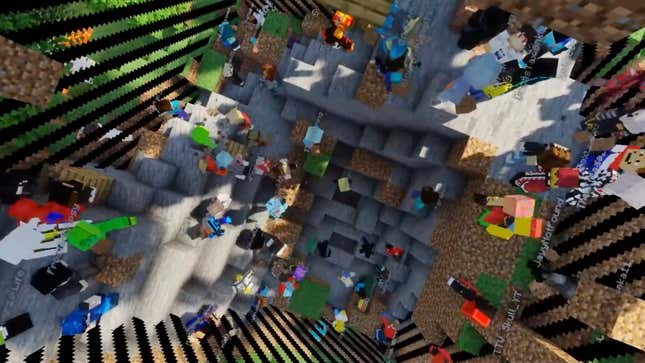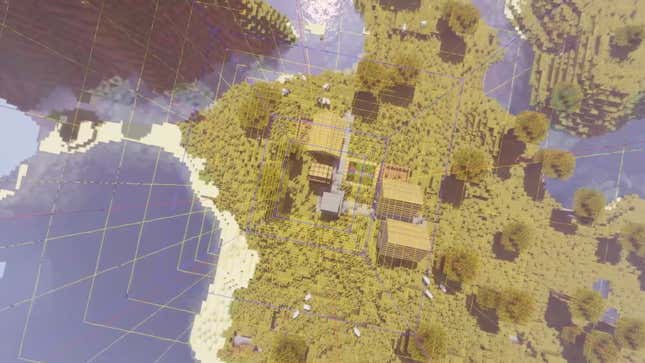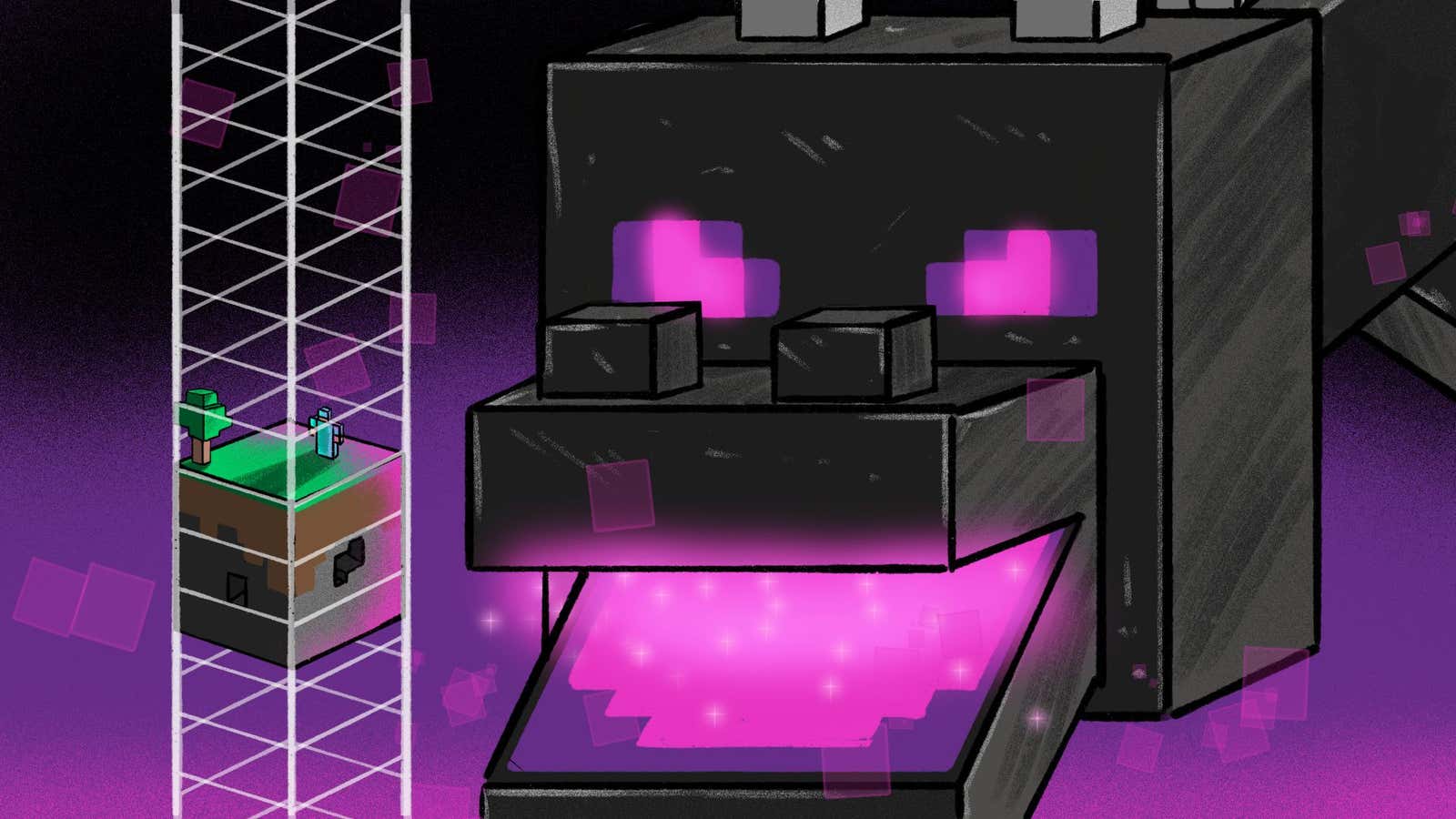Minecraft is nothing less than the best selling video game in history. It’s no mistake that Mojang’s masterpiece has ended up where it is: It is a game of infinite possibilities, where players are free to create whatever they want, with only their own imaginations as a limitation. It turns out that for some people, said imaginations have driven them to try to play the game without ever setting foot outside of the chunk in which they first spawned.
This new phenomenon has started taking YouTube by storm. The challenge sees players attempt to play—and sometimes beat—Minecraft right from the spot where they first appear. Which, if you’ve played the game, is seemingly impossible. And yet, we’ve spoken to a bunch of popular YouTubers who’ve succeeded at the task. Or at least, tried damned hard.
For many, the prospect of beating Minecraft may seem rather peculiar, as it’s so often played as an infinite sandbox. Indeed, when Minecraft was first created, it didn’t have an end goal at all. But in a 2009 Tumblr post, Minecraft’s creator, Markus “Notch” Persson, wrote about his vision for how Minecraft could have an ultimate objective. “While it could be fun to just see how long you can survive in survival mode, I believe there might be a need for some kind of goal. Make the most money in a month? Kill a big evil mob in the shortest time? I don’t know yet.”
Fast forward to 2011 and Notch joked on Twitter about naming this mythical end objective “the end.” Later that year, that joke came true, and the End dimension was teased in a Tweet, then officially announced two days later. Minecraft Java edition 1.0.0 added it as a playable dimension and its current form was born.

Going to the End in Minecraft is a complex process with multiple steps. You first need to go to the nether dimension to locate a nether fortress. Once there, you need to find Blaze— floating, fire-spitting, hostile mobs—and kill them to harvest the blaze rods that they drop. Using a crafting table, you turn the blaze rods into blaze powder, combine that with ender pearls collected from teleporting Endermen, and create eyes of ender. Once you have twelve of those, it’s time to locate the portal room in the fortress. Using those twelve eyes, you activate the portal and enter the End. Once there, you must battle the Ender dragon, Minecraft’s final boss. Beat it and the credits start rolling. Phew.
As you can imagine, this process is extraordinarily hard work under the best of conditions. So naturally, players thought, why not try doing it from the spot on which they spawned? Sure, some somehow succeed, but most have had to instead settle with the alternate challenge of living a predetermined number of in-game days—usually 100—inside that chunk. Itself no easy feat.
In Minecraft, chunks are regions of the world 256 blocks tall and 16-by-16 blocks wide. They’re the way the world generator splits the game’s infinite map into manageable pieces. A good analogy would be picturing an infinite jigsaw puzzle where the individual puzzle pieces are the chunks. Which is all to say, in an impossibly enormous game, they’re an extremely tiny region.
YouTuber Parrot, whose videos regularly reach millions of viewers, believes he was the first to take part in the challenge. “I was searching on YouTube for stuff about one chunk before this,” he tells Kotaku, “and I couldn’t find much besides modded worlds. I believe mine was the first vanilla chunk [in] 100 days. I was inspired by my good friend [Yeah] Jaron who made a ‘100 by 100 World’ series. I wanted to know what would happen if I made it even more difficult.”
So Parrot challenged himself to play Minecraft right on that opening chunk, with no mods, no cheats. To do this he would have to keep his character alive, somehow gathering enough food and water, while fending off attacks from mobs. His motivation for taking part was simple: he just wanted to see how tough it would be. “A lot of this came down to brainstorming,” Parrot told us, “and using all sorts of different Minecraft mechanics to succeed.”
He found gathering enough food to survive to be by far the most challenging aspect. “There were so many days where I was at zero hunger bars and had to eat rotten flesh. I found that the key was using the bones from skeletons to bonemeal the grass. From that grass you could get seeds and plant crops.”
Surviving 100 in-game days was largely a mental challenge for Parrot; staving off boredom was key. “I could’ve probably survived infinitely, but it was getting super boring by the final days.” So why didn’t he attempt to complete the whole game like this? Parrot believes it’s just not possible—using no cheats and no mods—without getting really lucky. “This wouldn’t be possible unless your chunk had the stronghold and a blaze spawner in the nether chunk,” he explained. He found it to be “extremely difficult,” which he says is the key to its popularity on YouTube.
YouTuber Laff, whose total following across platforms exceeds 500,000, recently took part in the challenge for his own series of videos. Taking it perhaps more literally, he played in a Minecraft world that was only one chunk large to start with. Laff tells Kotaku, “by far the most challenging part of my one chunk challenge was fighting the Ender dragon.” According to Laff, “coming into contact with her meant that I’d be launched far away from the single chunk that I was fighting on. I relied on Ender Pearls and an accurate aim to teleport back onto the platform when I was sent into the air. While skill was involved to survive the launch attacks, it felt like a lot of luck was needed as well.”
For Laff, by far the most surprising element was how easy it was to locate ores like iron and diamond on his chunk, vital for progressing in the game. “All I had to do was sneak on the edge and go into third person - I saw enough ore to make myself a full set of tools and armor!”
But such challenges needn’t be lonely affairs. If you’re going to confine yourself to a tiny space in a vast gaming world, why not do it with 99 of your closest frenemies?
Zach, who runs the YouTube channel LoverFella, organized 100 players to take part in a single chunk escapade. In his challenge, the players had to coexist and survive for 100 in-game days inside of a single chunk. The hardest part for him, he tells Kotaku, was the pre-production work in order to get the game off the ground. “To organize custom development work, create a server that can support 100 players in an area this small, and monitor the event for 30+ hours is really difficult. It wouldn’t be possible without the huge amount of people that help us run our server and network to give people these crazy experiences.”
But adding 100 players is not without its issues, both technically, and with the tendency of players to wreak havoc. “Adding more players offers more opportunity but also more complexity,” Zach tells Kotaku. When players would “learn to hack” or decide to “just join to destroy everything,” it posed a serious challenge. “One of our biggest problems was that it was really hard to identify the rule breakers. It’s hard to pick one person out of a giant group of 25, and it resulted in quite a few problems during our recording process.”
For players taking part, Zach says his participants really struggled with “the visual aspect of it. When 100 people are crammed into one tiny area, you almost can’t see anything! And the only place they can go when trapped is either up or down. So there was a constant struggle to see if you could leave the main floor and reach some peace towards the top or bottom of the world.”
This, inadvertently, led to an extraordinary class structure. “Players would protect their area of the build by breaking blocks or setting up traps, and after a few hours the middle section was a giant pit of players that couldn’t escape—while the few who made it to the top enjoyed food, homes, and peace from the chaos.”
Another popular YouTuber who got on board with this bizarre trend was TheMisterEpic. He showcased the work of the Minecraft@Home team, who spent two months searching for the “ideal seed, where everything lines up and is positioned correctly.” This was, he explained, “a seed where, directly below your feet, lay a stronghold and portal room.” His motivation for taking part was, like Parrot, to see how fast he could speedrun the game.
In order to achieve this, TheMisterEpic had to gather those ender pearls—needed to create the end portal. But in doing this, like Parrot, he also had to contend with boredom. He opted to be AFK a large percentage of the time, rather than sitting there as he waited for the villagers and sheep needed to regenerate. “I think I had Minecraft open 24 hours a day for four to five days straight,” he explains.
The creator behind the channel “FatMemeGod”, who declined to give his name, found the challenge extremely difficult for other reasons. He first saw Laff taking part, and “challenged him to a speed-run battle on one chunk.”
His difficulty with the challenge stemmed from the fact, he told Kotaku, that he “literally didn’t know anything about the game” before taking part in this challenge. Despite this massive disadvantage, incredibly, he eventually beat Laff. The journey there was about as Minecraft as stories get.
FatMemeGod’s luck initially started running out when his sheep spontaneously sheared themselves. This was quickly followed up by Laff building an impossibly long bridge to his chunk, in order to attack. It initially looked like FatMemeGod’s luck had turned around when he managed to teleport past Laff and kill him, but was surprised when Laff swam up the side of the chunk after respawning in a hidden underground bed . Minecraft, everybody.
Laff sabotaged FatMemeGod in the Nether by stealing all the resources he needed, and went to the End. By this point, Laff had already taken a third of the Ender dragon’s health, and the battle turned into a three way duel: Laff vs FatMemeGod vs the Ender dragon. FatMemeGod won when the Ender dragon flung Laff off the side of the chunk and appeared to get stuck, making it easy pickings.

However, not all players use perfectly selected world seeds for their playthroughs. Some prefer to go through the challenge more organically and just see what unfolds.
Kevin, who runs the enormously popular YouTube variety gaming channel “CallMeKevin,” also took part. In his series, like many others he contended largely with boredom and a lack of resources. Resources would frequently fall just a block or two outside of his chunk and cause him difficulty retrieving them. “This is all so annoying,” he told viewers, “trying to get the blocks and items that are just outside.” (Kevin could not be reached for comment.)
Anything that can give you an advantage in the challenge is considered a good thing. For both Parrot and Kevin, it came in the form of using different Minecraft mechanics to their advantage. Kevin placed boats just outside of his chunk, knowing that mobs would opt to sit inside and could not leave them. This proved a surprisingly effective defence system. Replies in the YouTube comments section of his videos tend to refer to the exploit as a “military genius” tactic.
Wool is a hard commodity to come by for most who partake, but it is essential to survive the night—it’s needed to craft beds. Laff and TheMisterEpic lucked out in this respect, both setting it so that they spawned into a chunk that was inside a village, where beds already existed. Kevin, on the other hand, just started in a randomly generated chunk without any of those luxuries. For him, finding wool was not something he was able to accomplish until the fifth episode in the series, when having given up on sheep ever wandering into his chunk, he was forced to use spiders to create the wool. But even this didn’t prove enough, and eventually he opted to expand the playable area to two chunks—a 16 by 32 square block area. ending his participation in the one chunk challenge and starting a 2 chunk challenge. As Kevin illustrates, beating the one chunk challenge isn’t possible in all situations.

Players of many open-ended games, from The Sims to Hitman to Minecraft, regularly seek out increasingly eccentric ways to stave off boredom, especially after all objectives have been beaten. Or, in Minecraft’s case, when they grow tired of infinite survival. This also impacts creators looking for content ideas, to feed the eternally hungry maw of YouTube’s whim.
As “TheSpiffingBrit” told me earlier this year, creators are in an endless arms race for viewer attention, competing with an algorithm no one understands. Coming up with seemingly outlandish or wacky challenges is frequently an outcome of this quest for clicks and monetizable content.
What makes this challenge different is that it grabs people’s attention and imagination without the need for controversy. It’s a welcome respite from the common themes of more provocative challenges, like the homeless or 100 baby challenges in The Sims. And does it in a way that’s uniquely...Minecraft.
Based on this, and the experiences of those I spoke to, should you give this a go? I’d have to say, “Why not!” Most creators featured here were either able to beat the Ender dragon, or successfully survive the 100 days they’d aimed for, so it’s certainly doable. Just be prepared for some frustration—it isn’t easy beating the Ender dragon while you’re being flung into orbit.
Updated: 11/26/21, 01.11 a.m. ET: Changed wording of a light-hearted remark about Kevin “cheating” by expanding his chunk.
Kyle Wilson is a freelance games journalist. You can find his Twitter here.
